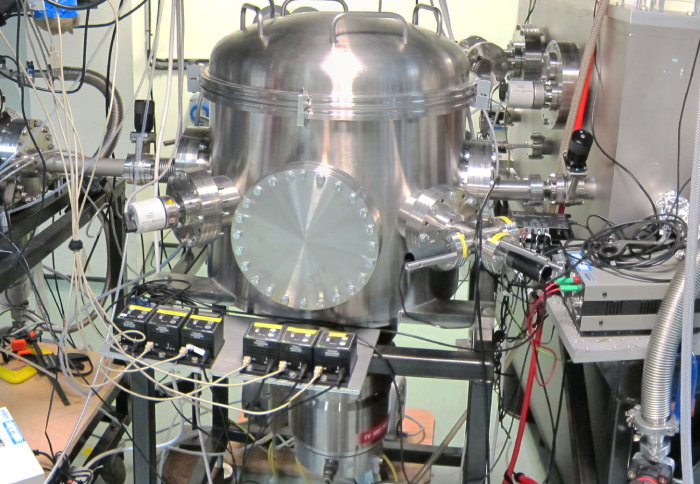X-rays from tabletop lasers allows scientists to peer through the ‘water window’

Studying the fleeting actions of electrons in organic materials will now be much easier, thanks to a new method for generating fast X-rays.
The technique means advanced measurements of fast reactions will now be possible in physics labs around the world, without having to wait to use expensive and scarce equipment. It could be used, for example, to study and improve light-harvesting technologies like solar panels and water splitters.
We are at the frontiers of what we can measure, seeing faster-than-ever processes important for science and technology. Professor Jon Marangos
When ‘soft’ X-rays, beyond the range of ultraviolet light, strike an object, they are strongly absorbed by some kinds of atoms and not others. In particular, water is transparent to these X-rays, but carbon absorbs them, making them useful for imaging organic and biological materials.
However, a challenge has been to generate very fast soft X-rays. Creating pulses of X-rays that only last one thousandth of a millionth of a millionth of a second would allow researchers to image the extremely quick motions of electrons, crucial for determining how charge travels and reactions occur.
Smallest and fastest reaction steps
Fast soft X-rays have been created with large facilities, such as multi-billion dollar costing free-electron lasers, but now a research team from Imperial College London have generated fast and powerful fast soft X-ray pulses using standard laboratory lasers.
The method, which can produce bright soft X-ray pulses that last hundreds of attoseconds (quintillionths of a second), is published today in Science Advances.
With the new technique, researchers will be able to watch the movement of electrons on their natural timescale, giving them a dynamic picture of the smallest and fastest reaction steps.
Senior author Professor Jon Marangos, from the Department of Physics at Imperial, said: “The strength of this technique is that it can be used by many physics labs around the world with lasers they already have installed.
“This discovery will allow us to make measurements at extreme timescales for the first time. We are at the frontiers of what we can measure, seeing faster-than-ever processes important for science and technology.”
Generating X-rays
Generating X-rays in a lab requires exciting atoms until they release photons – particles of light. Normally, atoms in a long, dispersed cloud are excited in sequence so that they emit photons in ‘phase’, meaning they add up and create a stronger X-ray pulse. This is known as phase matching.
We’ve managed to look inside what was before the relatively black-box of soft X-ray generation, and use that information to build an X-ray laser on a table that can compete with football-field spanning facilities. Allan Johnson
But when trying to generate soft X-rays this way, effects in the cloud of atoms strongly defocus the laser, disrupting phase matching.
Instead, the team discovered that they needed a thin, dense cloud of atoms and short laser pulses. With this setup, while the photons could not stay in phase over a long distance, they were still in phase over a shorter distance and for a short time. This led to unexpectedly efficient production of the short soft X-ray pulses.
The team further measured and simulated the exact effects that cause high harmonic generation in this situation, and from this were able to predict the optimum laser conditions for creating a range of X-rays.
Lead researcher Dr Allan Johnson, from the Department of Physics at Imperial, said: “We’ve managed to look inside what was before the relatively black-box of soft X-ray generation, and use that information to build an X-ray laser on a table that can compete with football-field spanning facilities. Knowledge is quite literally power in this game.”
Improving solar technologies
The team at Imperial plan to use the technique to study organic polymer materials, in particular those that harvest the Sun’s rays to produce energy or to split water. These materials are under intense study as they can provide cheaper renewable energy.
However, many currently used materials are unstable or inefficient, due to the action of electrons that are excited by light. Closer study of the fast interactions of these electrons could provide valuable insights into methods for improving solar cells and catalysts.
-
‘High-Flux Soft X-ray Harmonic Generation from Ionization-Shaped Few-Cycle Laser Pulses’ by Allan S. Johnson, Dane R. Austin, David A. Wood, Christian Brahms, Andrew Gregory, Konstantin B. Holzner, Sebastian Jarosch, Esben W. Larsen, Susan Parker, Christian S. Strüber, Peng Ye, John W. G. Tisch, and Jon P. Marangos is published in Science Advances.
Article supporters
Article text (excluding photos or graphics) © Imperial College London.
Photos and graphics subject to third party copyright used with permission or © Imperial College London.
Reporter
Hayley Dunning
Communications Division